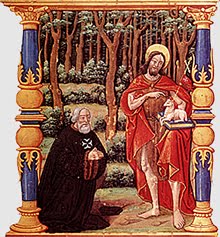BLESSED VILMOS APOR, MARTYR OF OUR ORDER
Today is the feast of one of the 20th Century's martyrs of our Order.
Vilmos (William) Apor, was born as a baron into a noble family in 1892, the son of Baron Gábor Apor and Countess Fidelia Pálffy ab Erdöd. He was an Hungarian bishop who earned a special reputation for his service to the poor, especially during the months of hardship that came at the end of the Second World War. He was a Chaplain and Prelate of our Order.
As a child he already felt his vocation to the sacred priesthood, and had asked his mother for a chalice and paten as a Christmas present when a small boy. He excelled in the study of Latin at school. Against his mother’s initial wishes, he was was eventually ordained to the priesthood in 1915, having studied under the Jesuits at Innsbruck, and celebrated his first Mass on 25 August with his mother and sisters in attendance.
He was famous for his commitment to the protection of abused women, the cause which would ultimately lead to his martyrdom. In this he shares with our Patron Saint John the Baptist the defence of the dignity of women and of marriage. Named Bishop of Györ by Pope Pius XII in 1941, he chose as his motto: “Crux firmat mitem, mitigate fortem” - The Cross strengthens the weak and makes the strong gentle. He was insistent in protesting to the Nazis against the persecution of the Hungarian Jews during the occupation, and during the many air raids on the city he opened his home to those whose houses had been destroyed. When Russian troops entered the city in 1945, many women, including Jews and religious, took refuge in the episcopal palace, he himself withdrawing to a small room.
On Good Friday 1945 three drunken Russian soldiers broke into the residence and demanded that the women be taken to their barracks, the women petrified of being raped. Monsignor Apor refused and placed himself in front of the women, to whom he was knows simply as ‘Uncle Vilmos’. One of the Russians shot and wounded him in the abdomen; out of fear at their cowardice they then fled, leaving the women unmolested. Bishop Apor survived in great agony for three days, operations to save him being unsuccessful, and died on 2nd April, Easter Monday, having made his confession and received the last rites. His death was witnessed by István Sándor, a young Salesian priest, himself also to be a martyr and blessed, who was at the time forced to work as a labourer by the Russians. Upon learning of his death, which came as a profound shock and loss to his diocese, the people of the city of Györ hailed him immediately as a great saint.
On 9th April 1947, the great Cardinal Mindszenty wrote to Father Csavossy, the postulator for the cause: “I can assure you that now is the appropriate time to introduce the canonization procedures. I wish it and officially approve of it, and want the necessary steps to be taken to do the same for all priests who lost their lives when protecting women.”
The theologian and Cardinal-elect Hans Urs von Balthasar was his nephew.
Blessed Vilmos’s tomb in Györ Cathedral, designed by the Hungarian artist Boldogfai Farkas Sándor, is an impressive piece of modern sculpture in red granite.
Blessed Vilmos Apor was beatified by Pope John Paul II on 9th November 1997, who confirmed that he was killed ‘in odium fidei’ (hatred of the Faith.)
Category (click to see all related):
Catholic life,
Faith












